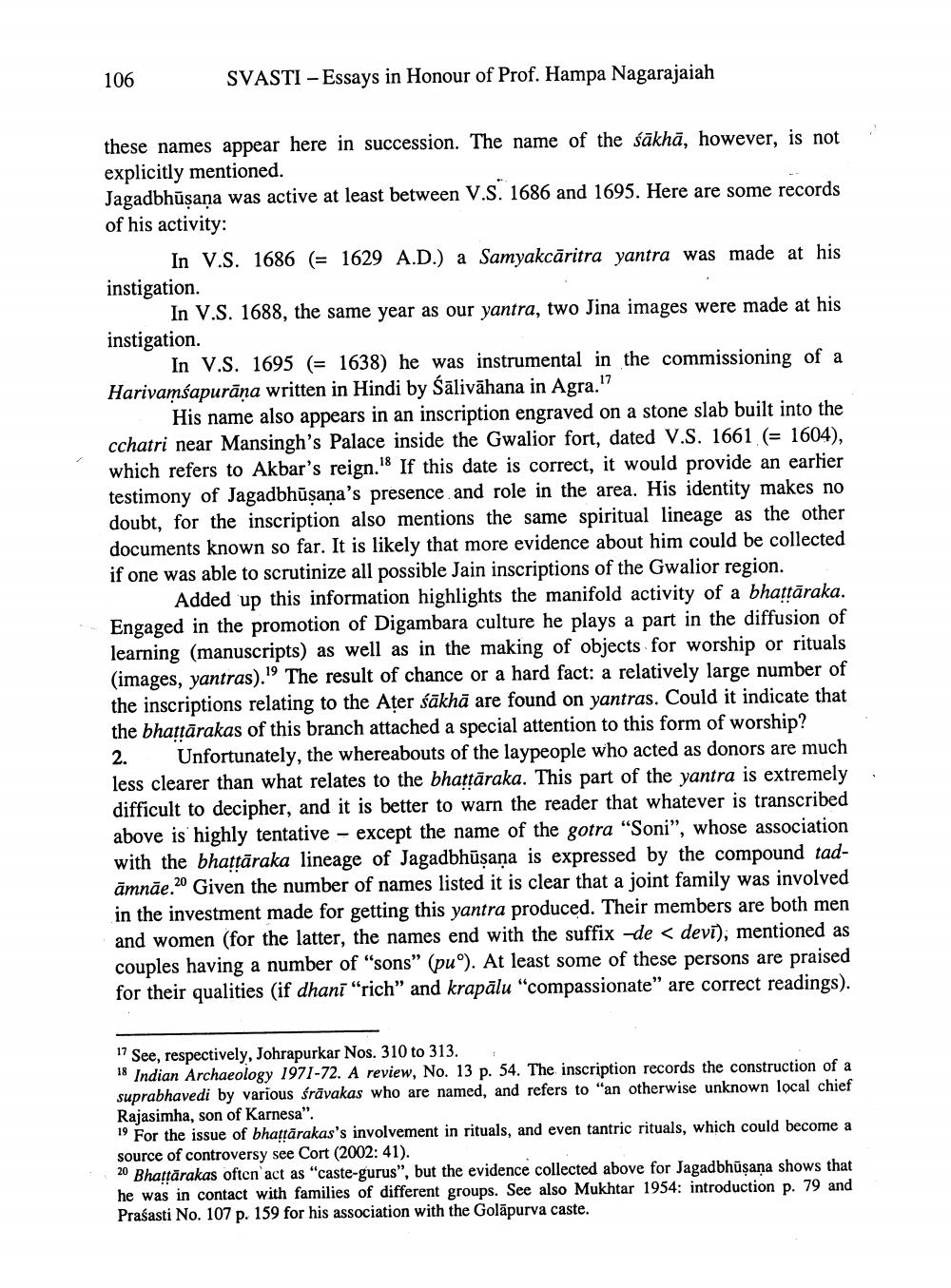________________
106
SVASTI Essays in Honour of Prof. Hampa Nagarajaiah
these names appear here in succession. The name of the säkha, however, is not explicitly mentioned.
Jagadbhüṣana was active at least between V.S. 1686 and 1695. Here are some records of his activity:
In V.S. 1686 (= 1629 A.D.) a Samyakcäritra yantra was made at his instigation.
In V.S. 1688, the same year as our yantra, two Jina images were made at his
instigation.
In V.S. 1695 (= 1638) he was instrumental in the commissioning of a Harivamsapurana written in Hindi by Śälivähana in Agra."7
18
His name also appears in an inscription engraved on a stone slab built into the cchatri near Mansingh's Palace inside the Gwalior fort, dated V.S. 1661 (= 1604), which refers to Akbar's reign." If this date is correct, it would provide an earlier testimony of Jagadbhüşana's presence and role in the area. His identity makes no doubt, for the inscription also mentions the same spiritual lineage as the other documents known so far. It is likely that more evidence about him could be collected if one was able to scrutinize all possible Jain inscriptions of the Gwalior region.
Added up this information highlights the manifold activity of a bhaṇṭāraka. Engaged in the promotion of Digambara culture he plays a part in the diffusion of learning (manuscripts) as well as in the making of objects for worship or rituals (images, yantras)." The result of chance or a hard fact: a relatively large number of the inscriptions relating to the Ater säkhä are found on yantras. Could it indicate that the bhaṇṭārakas of this branch attached a special attention to this form of worship?
2.
Unfortunately, the whereabouts of the laypeople who acted as donors are much less clearer than what relates to the bhaṇṭāraka. This part of the yantra is extremely difficult to decipher, and it is better to warn the reader that whatever is transcribed above is highly tentative except the name of the gotra "Soni", whose association with the bhattaraka lineage of Jagadbhüṣaṇa is expressed by the compound tadämnde. Given the number of names listed it is clear that a joint family was involved in the investment made for getting this yantra produced. Their members are both men and women (for the latter, the names end with the suffix -de < devi), mentioned as couples having a number of "sons" (pu°). At least some of these persons are praised for their qualities (if dhani "rich" and krapälu "compassionate" are correct readings).
17 See, respectively, Johrapurkar Nos. 310 to 313.
18 Indian Archaeology 1971-72. A review, No. 13 p. 54. The inscription records the construction of a suprabhavedi by various śravakas who are named, and refers to "an otherwise unknown local chief Rajasimha, son of Karnesa".
19 For the issue of bhaṭṭārakas's involvement in rituals, and even tantric rituals, which could become a source of controversy see Cort (2002: 41).
20 Bhaṭṭārakas often act as "caste-gurus", but the evidence collected above for Jagadbhüṣaṇa shows that he was in contact with families of different groups. See also Mukhtar 1954: introduction p. 79 and Prasasti No. 107 p. 159 for his association with the Golapurva caste.




